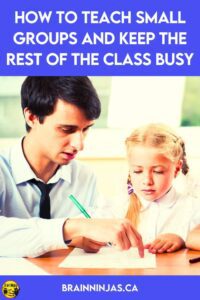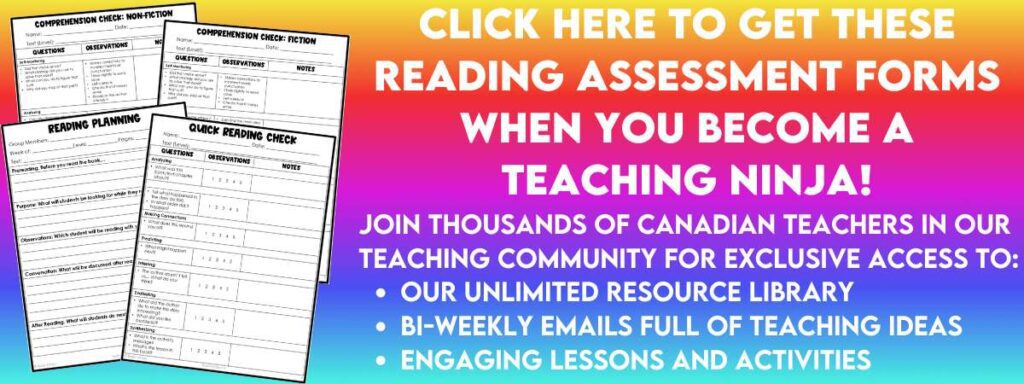
Hands down, this is the biggest question we get asked on a regular basis when working with teachers in the classroom. In fact, this is a question we ask ourselves daily. What will the other students be doing while I meet with my Guided Reading groups?
First of all, before you can make your time with your Guided Reading groups count, you need to establish the routines in your classroom. If you don’t have your classroom management down pat, your small group instruction time will be constantly interrupted and your students won’t progress. Nothing good will come from everyone being frustrated.
You can start preparing your students from the first day of school. Have a class discussion about how students feel when they are working with the teacher and someone comes to interrupt. Hopefully, they will come up with some ideas. Lead them toward feeling disappointed, frustrated or sad that their time gets taken away.
Tell your students that you value your time with them. Show them by giving them your undivided attention. It sounds easy, but it will take some work.
This post is part of our Guided Reading Series. If you’re brand new to Guided Reading, you might also want to read: Help! I Don’t Know How to Do Guided Reading!
Create Expectations

Come up with a class-generated list about what types of interruptions would be acceptable. Emergencies like fire drills, medical situations or special school announcements would all be acceptable reasons to interrupt the lesson at the table.
We love making a little poster with the class to help us remember and we always have a little fun with it. There are lots of creative examples online.
Create a sign or some non-verbal way to communicate in emergency situations. This helps because it prevents students who just want to ask you one question (because the other communication is non-verbal it is less disruptive). They are forced to use the sign/signal and then have to justify its use.
We also talk about what it looks like to work independently. Our expectations for this usually include: staying in one place, getting the work done, avoiding making noise (we use this because it includes talking and making random unnecessary noise) and being a good role model for our teammates.
Every single time we transition from whole class activities to small groups, we review the expectations and tailor them differently depending on the situation. We don’t start teaching until everyone is ready to be on task.
This means we don’t start teaching at the table until everyone has everything they need for the lesson. We also wait until the rest of the class is settled before we begin. By waiting until everyone is ready, it reduces interruptions.
Build Stamina
You will have to build some stamina with your students. They won’t be able to leave you alone for a whole thirty or forty minutes right from day one, but you will get there with practice.
We build stamina from the first day by doing some simple student interviews while the rest of the class works on reading independently. There will be more activities listed later, but this isn’t about the activity as much as it’s about developing the expectations and routines for students. You can find the Student Profiles and Questionnaires in our TpT Store ($USD) or our BN Shop ($CAN).

Start by explaining to your class that an important part of the teaching day is working with students one on one or in small groups. In order for that to happen, everyone in the class needs to work as a team to allow everyone to learn. We call this a Creating a Sense of Agency.
Review the expectations for what students should be doing (reading silently and independently) for a given amount of time. Visual timers can be a great way to help communicate how much time is left. Start with a realistic amount of time (like five minutes). It should be something attainable and easy to achieve. This will only be a temporary goal.
Start the timer and remind students that for the duration of the time, you cannot be interrupted (based on the acceptable interruptions the class agreed upon).
Once we’ve been successful, we try to “beat our time” each time we do this (and we try it every single day until we get to the goal).
Once students reach fifteen minutes working independently, we start assessing student reading using our Quick Check so we can get ready to Guided Reading groups.
Practice
So, you’ve given your students a simple task such as silent reading. This is a good place to start, especially at the beginning when your students don’t have much started yet.
Have all of your students find a book or two and a comfortable place to sit. Ask the student you’re going to interview to go to the place you’ll be doing the interview (your Guided Reading table is a great place because then all your students get into the routine that when you’re at the table, you can’t be interrupted).
Set your timer. Review the expectations and go. Now comes the hard part.
Stick to It

They will test you and you need to be firm and consistent if this is going to work. For the entire duration of the timer, the ONLY student you can talk to is the student you’ve invited to the table.
If students are off-task, make a note, but wait until the timer goes off to address it unless there is a safety or emergency issue.
Stopping what you’re doing at the table to correct behaviour sends two messages: first, your time with the student at the table is not important and two, the misbehaving student gets attention first. Those are not the messages you want to send.
After the timer goes off, address what worked with the whole class. Maybe keep a record of how many minutes students can work without interruptions or how many minutes students can stay on task. Set a class goal and see if they can achieve it. Build up the stamina by adding a few minutes each time.
Address any misbehaviour with individual students one on one. This will show the student they won’t get special attention for acting out, but that you did notice and you’ll be watching to see if they can do it better next time.
Some Tips & Tricks to Help
Use Visuals as Reminders
Eventually, your students will be working for about thirty to forty minutes while you work with a small group. That might be a little too long for all your students to remember all the things they’re supposed to be getting done.
Write a list on the board or have a checklist for students to follow. Go through this list before setting to work.
Put a Student in Charge
Allow a student to be the one who takes questions from the independent workers. It will be inevitable that a student can’t remember where to get a certain material or where to put something when it’s done. Students can answer these questions, so it’s best to train students to help each other instead of coming to you for every single question.
Give your student leaders specific things to be in charge of so they can take care of the little stuff on your behalf. Examples of this might be monitoring who leaves the room to use the bathroom, which students handed in an activity, knowing all the steps for a project, being able to explain how to do something or anything else students would generally come and ask you.

Choose a Secret Person
This can be a fun game at the beginning of the year to get a little buy-in from students. Explain to the class that you will be picking a name from the class list randomly. If that person is working on-task when the name is drawn, that person will win a prize.
It works really well if you pick a student who sometimes has a difficult time staying on task and you “catch” them being really good. It’s also a good way to reward your students who are doing their best.
Choose an Activity
This is always more challenging at the beginning of the year when you’re not as deep into your curriculum. Once your year is rolling, students could technically work on ANYTHING you have been working on.
When choosing activities, pick things they can do independently, even if this means they need to be a little simpler in order for them to get it done. You don’t need to “mark” everything. It is ok for this work to be fluff in the beginning. These can be practice activities or busy work to start. Eventually, as you get to know your students better and train them to work for longer periods of time independently, you can give them more challenging items and more meaningful work.
Weekly Reading Skills Make Our Planning Lives Easier
We started creating weekly reading skill sets that our students could work on while we were meeting with Guided Reading Groups. This combined some of the content area topics from science and social studies with some of the literacy skills including comprehension strategies and grammar.
When the pandemic hit, we turned each set into a digital version and decided that other teachers might benefit from them as well. These activities can be used in the classroom or for distance teaching.
You can try out a free set of activities by grabbing one of our free Weekly Reader Sets:
Each reading passage comes with several activities that specifically focus on different text features.
You can try this set about Writing-On-Stone Provincial Park with your Grade 4 students. Find it on TpT ($USD) or our BN Shop ($CAN).
We also have a Grade 5 set about Permafrost. Find it on TpT ($USD) or our BN Shop ($CAN).
You can find all of our Weekly Reading Comprehension Sets on TpT ($USD) or our BN Shop ($CAN).
Here are some other simple activities we use with our students:
- silent reading
- partner reading (two students sit together with the same text and read at the same time or take turns reading sentence by sentence, paragraph by paragraph, page by page, or chapter by chapter depending on the text)
- projects from any subject that you have on the go. Check out our post: The Reasons for Project Based Learning for some specific projects.
- reading response activities such as Twisted Lit Circles. Once you’re more established in your reading groups, you’ll have activities students can do in between your meetings. Read more in this post: Twisted Literature Circles.
- word study or spelling activities
- grammar practice
- writing
- drawing about what they have read
- keeping a reading journal
- meeting with group members to discuss what they’ve read. We use this activity when we do Book Clubs. We using use Google Meet for this sometimes.
- listening to audiobooks
Hands down, the biggest challenge to keeping students working while you meet with Guided Reading groups is classroom management. If you have clear expectations that you practice as you build up independent working stamina, you’ll have much more success. If you let it slide, they will slide too.
We have a whole post about classroom management.
How Long Does it Take?
To be honest, it will depend on the age and abilities of your students. Most years, we start building stamina with five minute increments right from the first day of school. We build this up over the entire first month of school so that by the time we have all of our grade four and five students assessed and have put together our groups, we’re able to work for thirty-five to forty minutes.
Usually, we formally start our Guided Reading groups five to six weeks into the school year. Prior to that we always read a book aloud to students. We use this to model some of the reading skills and reading responses we’ll be using during the year. We also use this time to assess student reading levels and gathering materials we’ll need to teach reading.
Occasionally we need to review this process (especially after longer breaks like Spring Break or Winter Break). It doesn’t take as long to get students back into shape if we do it right at the beginning of the year.
There is still so much to teach you. If Guided Reading is brand new to you, start with Help! I Don’t Know How to Teach Reading. Then check out our posts How to Prepare For Your Guided Reading Groups and How to Run Your Guided Instruction.
Are you looking for other Language Arts ideas?
- Give Your Reading Instruction an Easy Twist
- How to Teach Reading With Book Clubs
- How to Use Google Meet to Run a Book Club
- Research Skills: How to Teach Text Features
- How to Celebrate Poem in Your Pocket Day
- Practical Strategies for Reluctant Readers
- Add Great Content to Your Literacy Lessons
- How to Set Up Your Reading Comprehension Schedule
- Challenge Your Students with Writing Activities Every Day
- 22 Amazing Ways to Use Word Wall Words
- How to Include Different Types of Writing in Your Classroom
What are you still wondering about when it comes to using Guided Reading as a strategy to teach reading? Reach out to us with your questions! And be sure to leave a comment below!







